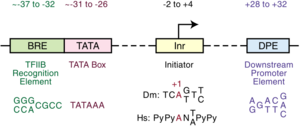Biology:Downstream promoter element

In molecular biology, a downstream promoter element (DPE) is a core promoter element. Like all core promoters, the DPE plays an important role in the initiation of gene transcription by RNA polymerase II. The DPE was first described by T. W. Burke and James T. Kadonaga in Drosophila melanogaster at the University of California, San Diego in 1996.[2] It is also present in other species including humans, but not Saccharomyces cerevisiae.[3]
Together with the initiator motif (Inr), another core promoter element, the DPE is recognized by the transcription factor II D (TFIID) subunits TAF6 and TAF9.[2][4][5] It has been shown that DPE-dependent basal transcription depends highly on the Inr (and vice versa) and on correct spacing between the two elements.[2][4][6]
The DPE consensus sequence was originally thought to be RGWCGTG,[2] however more recent studies have suggested it to be the similar but more general sequence RGWYV(T).[lower-alpha 1][1][3][7] It is located about 28–33 nucleotides downstream of the transcription start site.[3]
Occurrence
It has been shown that the DPE is about as widely used as the TATA box in D. melanogaster.[6] While a DPE was found in many promoters that do not contain a TATA box, there are also promoters that contain both a TATA box and a DPE.[6]
The promoters of nearly all Hox genes of D. melanogaster, with the exception of the evolutionarily most recent genes, Ubx and Abd-A, contain a DPE motif and lack a TATA box.[8] Drosophila promoters containing the DPE sequence include Abd-B, Antp P2, bride of sevenless, brown, caudal, E74, E75, engrailed, Gsα, labial, nmMHC, ras2, singed, stellate, and white.[2] In organisms other than D. melanogaster, the promoter of the human and mouse IRF1 gene has been found to contain a DPE consensus sequence at the appropriate distance from the transcription start site. This promoter, too, does not contain a TATA box.
DPE has also been reported to play role in primitive Eukaryote Entamoeba histolytica.[9]
Notes
- ↑ In nucleic acid notation for DNA, R (puRine) stands for A/G (adenine or guanine, which are both purines); W (Weak) stands for A/T (adenine or thymine, which both form only two hydrogen bonds); Y (pYrimidine) stands for C/T (cytosine or thymine, which are both pyrimidines); and V stands for A/C/G.
References
- ↑ 1.0 1.1 Butler, Jennifer E F; Kadonaga, James T (15 October 2002). "The RNA polymerase II core promoter: a key component in the regulation of gene expression". Genes & Development 16 (20): 2583–2592. doi:10.1101/gad.1026202. PMID 12381658.
- ↑ 2.0 2.1 2.2 2.3 2.4 Burke, T W; Kadonaga, J T (15 March 1996). "Drosophila TFIID binds to a conserved downstream basal promoter element that is present in many TATA-box-deficient promoters.". Genes & Development 10 (6): 711–724. doi:10.1101/gad.10.6.711. PMID 8598298.
- ↑ 3.0 3.1 3.2 Juven-Gershon, Tamar; Kadonaga, James T. (March 2010). "Regulation of gene expression via the core promoter and the basal transcriptional machinery". Developmental Biology 339 (2): 225–229. doi:10.1016/j.ydbio.2009.08.009. PMID 19682982.
- ↑ 4.0 4.1 Burke, Thomas W.; Kadonaga, James T. (15 November 1997). "The downstream core promoter element, DPE, is conserved from Drosophila to humans and is recognized by TAFII60 of Drosophila". Genes & Development 11 (22): 3020–3031. doi:10.1101/gad.11.22.3020. PMID 9367984.
- ↑ Yang, Chuhu; Bolotin, Eugene; Jiang, Tao; Sladek, Frances M.; Martinez, Ernest (March 2007). "Prevalence of the initiator over the TATA box in human and yeast genes and identification of DNA motifs enriched in human TATA-less core promoters". Gene 389 (1): 52–65. doi:10.1016/j.gene.2006.09.029. PMID 17123746.
- ↑ 6.0 6.1 6.2 Kutach, Alan K; Kadonaga, James T (1 July 2000). "The Downstream Promoter Element DPE Appears To Be as Widely Used as the TATA Box in Drosophila Core Promoters". Molecular and Cellular Biology 20 (13): 4754–4764. doi:10.1128/MCB.20.13.4754-4764.2000. PMID 10848601.
- ↑ Kadonaga, James T (September 2002). "The DPE, a core promoter element for transcription by RNA polymerase II". Experimental & Molecular Medicine 34 (4): 259–264. doi:10.1038/emm.2002.36. PMID 12515390.
- ↑ Juven-Gershon, Tamar; Hsu, Jer-Yuan; Kadonaga, James T. (15 October 2008). "Caudal, a key developmental regulator, is a DPE-specific transcriptional factor". Genes & Development 22 (20): 2823–2830. doi:10.1101/gad.1698108. PMID 18923080.
- ↑ Naiyer, Sarah; Kaur, Devinder; Ahamad, Jamaluddin; Singh, Shashi Shekhar; Singh, Yatendra Pratap; Thakur, Vivek; Bhattacharya, Alok; Bhattacharya, Sudha (2019-03-12). "Transcriptomic analysis reveals novel downstream regulatory motifs and highly transcribed virulence factor genes of Entamoeba histolytica". BMC Genomics 20 (1): 206. doi:10.1186/s12864-019-5570-z. PMID 30866809.
 |

